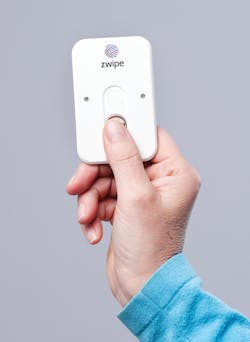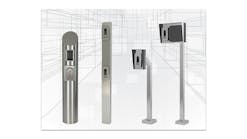First there were bar code cards. They evolved to magnetic stripe cards which evolved into proximity cards. As proximity became the predominant credential technology over the last decade, it’s evident that contactless smart cards will replace proximity and the other legacy credential technologies over the next three to five years. That’s because the multi-application flexibility of contactless smart cards lets an organization use them for logical/information access control, time and attendance and other applications in addition to physical access control. Each application gets its own memory space on the card or tag and security keys prevent one application from accessing another. For those considering biometrics at some of their access points, the card can even hold the biometric template.
Nonetheless, there still remains a problem with the smart card. Who is presenting the smart card to the reader? The system doesn’t know. All it can understand is that an authorized card has been presented to the reader. Thus, the door should open, respective of who is holding the card.
Yes, a biometric template carried within the card could help solve that problem but at what expense? To do so, it needs a biometric reader, an additional piece of hardware, raising the infrastructure cost to do what the card should be doing in the first place, verifying who is trying to enter.
Why not put biometrics directly on the smart card? There would be no additional hardware to buy and the smart card wouldn’t work unless verified by the authorized person’s thumbprint on the card. With a biometric card, the organization would reap all of the security and access control advantages of the smart card plus biometrics.
From Then To Now
Let’s review the most commonly used types of card technologies used today.
Bar Codes. Some facilities still use bar code badges, the least secure of all credentials. They are what they sound like. A bar code reader scans the bar code to allow access. However, since the bar code is visible, it can be reproduced very easily. There is a solution, though. By covering the bar code with an opaque film, the badge is only read by a UV bar code reader. Of course, this raises the cost.
Magnetic Stripe. No different than the common, ordinary credit card, information on a magnetic stripe card is held on a strip of coated magnetic recording tape. Since the stripe must come in contact with the reader, there is ultimate wear-and-tear on the card. There’s a reason that they’re the de facto credential for credit companies. They’re less costly and easier to produce than other badges. Of course, this also means that they are easy to forge, making their security questionable. Nonetheless, they are successfully used by thousands of companies who require only simple access.
Proximity Badges and Tokens. This is today’s most widely used access control technology for two main reasons. First, there is no contact between cards and the reader. This eliminates the wear-and-tear factor. Second, proximity readers can be made very durable or even hidden into another structure to make them relatively vandal-resistant. Badges contain an antenna with microchip. As the badge enters a “wake-up” field, the electronics inside the badge power up and send the encoded information to the reader.
There are three types of proximity badges. The read only, true to its name, can only be read. The number cannot be changed. Read/write badges can have their numbers re-programmed.
Multi-technology badges are proximity badges that also employ another technology. For instance, leading vendors provide such badges in combinations such as proximity/magnetic stripe. These are typically employed where a company has an older legacy access control credential technology and wants to migrate without eliminating access to buildings. This is especially important for companies with multiple facilities. In other cases, the company cafeteria or some other application may only take magnetic stripe or the other technology credentials.
Contact Smart Cards. These cards contain a microchip that holds and processes large amounts of information. Metal pads on the card make contact with the reader to power up the circuitry and communication with the microprocessor. As a contact technology, though, they suffer the effects of wear-and-tear.
Contactless Smart Cards. This technology is ideal for physical access control and other applications. It is more secure than the proximity card and provides greatly increased flexibilities. With their lower reader costs, reduced costs of system ownership and increased applications opportunities, every security professional needs to more closely appraise contactless smart cards as they review their present systems.
The Biometric Card
A contactless smart card credential with on-card fingerprint reading provides all the assets of the smart card and eliminates its most glaring deficiency, knowing who is holding it. The biometric card reads the user’s fingerprint in less than a second. Eliminating the problems of solely deploying PINs and standard cards, the wirelessly powered biometric card lets users authenticate themselves directly on the card through something they are, a fingerprint or thumbprint. Only then will the card system activate the lock. This is much more secure than simply using a standard card, which verifies only something the user carries.
An on-card fingerprint scanner with 3D capacitive technology resides on the contactless smart card which has universal compatibility with all ISO 14443 readers from the leading brands. The biometric card is DESFIRE EV1 and MIFARE Classic compatible. Without having to change out an organization’s existing readers, the biometric card provides an easy, low cost way for organizations to provide a biometric upgrade to access control systems using smart card readers or multi-technology readers that also read smart cards.
Thus, the biometric card is more secure to use than other available ID and authentication solutions on the market today. The fingerprint data is captured by the on-card fingerprint scanner and is encrypted and stored only inside the card. No exchange of data is conducted with external systems. This provides secure template management since the fingerprint never leaves the card. It also eliminates user concerns with privacy issues. The card is unique to the user and only the authorized card holder can activate card communication with the reader. When a positive match occurs, the biometric card activates encrypted communication with the lock or reader in the same way as other ISO 14443 contactless smart cards.
No longer do organizations need to worry if someone not authorized to enter is using another person’s ID card. With the biometric directly on the card, they can be assured that the only people getting in are those authorized to do so.
Kim Humborstad is CEO of Zwipe. For more information on Zwipe biometric cards, visit www.zwipe.com.






